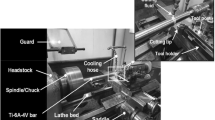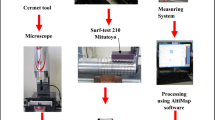Abstract
The objective of this research was to investigate the effectiveness of application of liquid nitrogen (LN2) in turning of Inconel 718 compared to flooded cutting and select suitable LN2 cutting parameters using response surface methodology (RSM). The results of turning experiments conducted by spraying LN2 to the cutting area of Inconel 718 bar showed that using either low or high cutting parameters, cutting performance of Inconel 718 under the cryogenic condition was generally worse than the flooded cutting. However, using the medium cutting parameters, the LN2 cutting performance was as good as that of the flooded cutting both showing a cutting force of 90 N, 60 µm of flank wear and 0.5–0.6 µm of surface roughness (Ra). These parameters were further optimized using desirability function of RSM to determine the set of parameters that provided the lowest cutting force, flank wear and Ra values and the highest material removal rate (MRR) under cryogenic cutting. Analysis of variance (ANOVA) performed on the regression models developed showed that cutting speed was the only significant factor on the cutting force. Feed rate was the most influential parameter on the flank wear. Feed rate and depth of cut were significant factors both affecting Ra. Multi-objective optimization showed that a cutting speed of 87 m/min, a feed rate of 0.06 mm/rev and a depth of cut of 0.37 mm constituted the optimum cutting parameters for achieving a cutting force of 78 N, flank wear of 58 µm, Ra of 0.49 µm and the MRR of 1.97 cm3/min under the cryogenic cutting condition.


















Similar content being viewed by others
Abbreviations
- LN 2 :
-
Liquid nitrogen
- RSM:
-
Response surface methodology
- V c :
-
Cutting speed
- ANOVA:
-
Analysis of variance
- a p :
-
Depth of cut
- CCD :
-
Central composite design
- f :
-
Feed rate
- SS :
-
Sum of squares
- F c :
-
Cutting force
- MS:
-
Mean of squares
- MRR:
-
Material removal rate
- MSE:
-
Mean square of error
- BUE:
-
Built-up edge
- DF:
-
Degree of freedom
- Ra :
-
Average Surface roughness
- P-Value:
-
Probability value
- VB B :
-
Flank wear
- CRP:
-
Contribution percentage
- \({R}^{2}\) :
-
Coefficient of determination
- DOC :
-
Depth of cut
References
Donachie MJ, Donachie SJ (2002) Superalloys: a technical guide. ASM international, Ohio, USA
Eskandari B, Davoodi B, Ghorbani H (2018) Multi-objective optimization of parameters in turning of N-155 iron-nickel-base superalloy using gray relational analysis. J Braz Soc Mech Sci Eng 40(4):233. https://doi.org/10.1007/s40430-018-1156-y
Zhu D, Zhang X, Ding H (2013) Tool wear characteristics in machining of nickel-based superalloys. Int J Mach Tools Manuf 64:60–77. https://doi.org/10.1016/j.ijmachtools.2012.08.001
Debnath S, Reddy MM, Yi QS (2016) Influence of cutting fluid conditions and cutting parameters on surface roughness and tool wear in turning process using Taguchi method. Measurement 78:111–119. https://doi.org/10.1016/j.measurement.2015.09.011
Davoodi B, Eskandari B (2019) Evaluation of surface damage mechanisms and optimisation of cutting parameters in turning of N-155 iron-nickel-base superalloy. Int J Mach Mach Mater 21(1–2):100–114
Thakur A, Gangopadhyay S (2016) State-of-the-art in surface integrity in machining of nickel-based super alloys. Int J Mach Tools Manuf 100:25–54. https://doi.org/10.1016/j.ijmachtools.2015.10.001
Ezugwu EO, Bonney J (2004) Effect of high-pressure coolant supply when machining nickel-base, Inconel 718, alloy with coated carbide tools. J Mater Process Technol 153–154:1045–1050. https://doi.org/10.1016/j.jmatprotec.2004.04.329
Hegab H, Umer U, Soliman M, Kishawy HA (2018) Effects of nano-cutting fluids on tool performance and chip morphology during machining Inconel 718. Int J Adv Manuf Technol 96(9):3449–3458. https://doi.org/10.1007/s00170-018-1825-0
Tadavani SA, Shoja Razavi R, Vafaei R (2017) Pulsed laser-assisted machining of Inconel 718 superalloy. Opt Laser Technol 87:72–78. https://doi.org/10.1016/j.optlastec.2016.07.020
Parida AK, Maity K (2019) Numerical and experimental analysis of specific cutting energy in hot turning of Inconel 718. Measurement 133:361–369. https://doi.org/10.1016/j.measurement.2018.10.033
Parida AK, Maity K (2021) Study of machinability in heat-assisted machining of nickel-base alloy. Measurement 170:108682. https://doi.org/10.1016/j.measurement.2020.108682
Bai W, Bisht A, Roy A, Suwas S, Sun R, Silberschmidt VV (2019) Improvements of machinability of aerospace-grade Inconel alloys with ultrasonically assisted hybrid machining. Int J Adv Manuf Technol 101(5):1143–1156. https://doi.org/10.1007/s00170-018-3012-8
Khuri AI, Mukhopadhyay S (2010) Response surface methodology. Wiley Interdiscip Rev Comput Stat 2(2):128–149
Koyee RD, Heisel U, Eisseler R, Schmauder S (2014) Modeling and optimization of turning duplex stainless steels. J Manuf Process 16(4):451–467. https://doi.org/10.1016/j.jmapro.2014.05.004
Sivalingam V, Zhao Y, Thulasiram R, Sun J, kai G, Nagamalai T, (2021) Machining behaviour, surface integrity and tool wear analysis in environment friendly turning of Inconel 718 alloy. Measurement 174:109028. https://doi.org/10.1016/j.measurement.2021.109028
Davoodi B, Eskandari B (2015) Tool wear mechanisms and multi-response optimization of tool life and volume of material removed in turning of N-155 iron–nickel-base superalloy using RSM. Measurement 68:286–294. https://doi.org/10.1016/j.measurement.2015.03.006
Günay M, Korkmaz ME, Yaşar N (2020) Performance analysis of coated carbide tool in turning of Nimonic 80A superalloy under different cutting environments. J Manuf Process 56:678–687. https://doi.org/10.1016/j.jmapro.2020.05.031
Zhang P, Liu Z, Du J, Su G, Zhang J, Xu C (2020) On machinability and surface integrity in subsequent machining of additively-manufactured thick coatings: a review. J Manuf Process 53:123–143. https://doi.org/10.1016/j.jmapro.2020.02.013
Krishnamurthy G, Bhowmick S, Altenhof W, Alpas AT (2017) Increasing efficiency of Ti-alloy machining by cryogenic cooling and using ethanol in MRF. CIRP J Manuf Sci Technol 18:159–172. https://doi.org/10.1016/j.cirpj.2017.01.001
Yildiz Y, Nalbant M (2008) A review of cryogenic cooling in machining processes. Int J Mach Tools Manuf 48(9):947–964. https://doi.org/10.1016/j.ijmachtools.2008.01.008
Pusavec F, Hamdi H, Kopac J, Jawahir IS (2011) Surface integrity in cryogenic machining of nickel based alloy—Inconel 718. J Mater Process Technol 211(4):773–783. https://doi.org/10.1016/j.jmatprotec.2010.12.013
Hong SY, Zhao Z (1999) Thermal aspects, material considerations and cooling strategies in cryogenic machining. Clean Prod Process 1(2):107–116. https://doi.org/10.1007/s100980050016
Hong SY, Ding Y, Jeong J (2002) Experimental evaluation of friction coefficient and liquid nitrogen lubrication effect in cryogenic machining. Mach Sci Technol 6(2):235–250. https://doi.org/10.1081/MST-120005958
Ali Khan M, Jaffery SHI, Khan M, Younas M, Butt SI, Ahmad R, Warsi SS (2019) Statistical analysis of energy consumption, tool wear and surface roughness in machining of titanium alloy (Ti-6Al-4V) under dry, wet and cryogenic conditions. Mech Sci 10(2):561–573. https://doi.org/10.5194/ms-10-561-2019
Khan MA, Jaffery SHI, Khan M, Younas M, Butt SI, Ahmad R, Warsi SS (2020) Multi-objective optimization of turning titanium-based alloy Ti-6Al-4V under dry, wet, and cryogenic conditions using gray relational analysis (GRA). Int J Adv Manuf Technol 106(9):3897–3911. https://doi.org/10.1007/s00170-019-04913-6
Kaynak Y (2014) Evaluation of machining performance in cryogenic machining of Inconel 718 and comparison with dry and MQL machining. Int J Adv Manuf Technol 72(5):919–933. https://doi.org/10.1007/s00170-014-5683-0
Stephenson DA, Skerlos SJ, King AS, Supekar SD (2014) Rough turning Inconel 750 with supercritical CO2-based minimum quantity lubrication. J Mater Process Technol 214(3):673–680. https://doi.org/10.1016/j.jmatprotec.2013.10.003
Iturbe A, Hormaetxe E, Garay A, Arrazola PJ (2016) Surface integrity analysis when machining Inconel 718 with conventional and cryogenic cooling. Procedia CIRP 45:67–70. https://doi.org/10.1016/j.procir.2016.02.095
Tebaldo V, di Confiengo GG, Faga MG (2017) Sustainability in machining: “eco-friendly” turning of Inconel 718. Surface characterisation and economic analysis. J Clean Prod 140:1567–1577. https://doi.org/10.1016/j.jclepro.2016.09.216
Musavi SH, Davoodi B, Eskandari B (2020) Evaluation of surface roughness and optimization of cutting parameters in turning of AA2024 alloy under different cooling-lubrication conditions using RSM method. J Cent South Univ 27(6):1714–1728. https://doi.org/10.1007/s11771-020-4402-2
Shokrani A, Dhokia V, Newman ST (2016) Investigation of the effects of cryogenic machining on surface integrity in CNC end milling of Ti–6Al–4V titanium alloy. J Manuf Process 21:172–179. https://doi.org/10.1016/j.jmapro.2015.12.002
Pusavec F, Deshpande A, Yang S, M’Saoubi R, Kopac J, Dillon OW, Jawahir IS (2014) Sustainable machining of high temperature Nickel alloy – Inconel 718: part 1 – predictive performance models. J Clean Prod 81:255–269. https://doi.org/10.1016/j.jclepro.2014.06.040
Sharman ARC, Hughes JI, Ridgway K (2015) The effect of tool nose radius on surface integrity and residual stresses when turning Inconel 718™. J Mater Process Technol 216:123–132. https://doi.org/10.1016/j.jmatprotec.2014.09.002
Shaw MC, Cookson J (2005) Metal cutting principles, vol 2. Oxford University Press, New York
International Standard ISO 3685 (1993) Tool-life testing with single-point turning tools
Montgomery DC (2017) Design and analysis of experiments. John wiley & sons
Pawade RS, Sonawane HA, Joshi SS (2009) An analytical model to predict specific shear energy in high-speed turning of Inconel 718. Int J Mach Tools Manuf 49(12):979–990. https://doi.org/10.1016/j.ijmachtools.2009.06.007
Iturbe A, Giraud E, Hormaetxe E, Garay A, Germain G, Ostolaza K, Arrazola PJ (2017) Mechanical characterization and modelling of Inconel 718 material behavior for machining process assessment. Mater Sci Eng, A 682:441–453. https://doi.org/10.1016/j.msea.2016.11.054
Trent EM, Wright PK (2000) Metal cutting. Butterworth-Heinemann, USA
Zhuang K, Zhang X, Zhu D, Ding H (2015) Employing preheating- and cooling-assisted technologies in machining of Inconel 718 with ceramic cutting tools: towards reducing tool wear and improving surface integrity. Int J Adv Manuf Technol 80(9):1815–1822. https://doi.org/10.1007/s00170-015-7153-8
Sata T, Shaw M (1964) Behavior of cellular materials undergoing plastic flow. CIRP Ann 12:190
Archdeacon TJ (1994) Correlation and regression analysis: a historian's guide. University of Wisconsin Press
Pritschet L, Powell D, Horne Z (2016) Marginally significant effects as evidence for hypotheses: changing attitudes over four decades. Psychol Sci 27(7):1036–1042. https://doi.org/10.1177/0956797616645672
Sandvik Coromant Catalogs: Turning Tools (2017). Page A344, Sweden
Funding
This research was supported by the Natural Sciences and Engineering Research Council of Canada (NSERC) under the CANRIMT Strategic Research Network Grant NETGP 479639- 15.
Author information
Authors and Affiliations
Corresponding author
Ethics declarations
Competing interests
The authors declare no competing interests.
Additional information
Publisher's Note
Springer Nature remains neutral with regard to jurisdictional claims in published maps and institutional affiliations.
Rights and permissions
About this article
Cite this article
Eskandari, B., Bhowmick, S. & Alpas, A.T. Turning of Inconel 718 using liquid nitrogen: multi-objective optimization of cutting parameters using RSM. Int J Adv Manuf Technol 120, 3077–3101 (2022). https://doi.org/10.1007/s00170-022-08906-w
Received:
Accepted:
Published:
Issue Date:
DOI: https://doi.org/10.1007/s00170-022-08906-w




